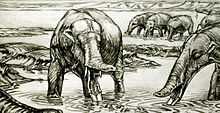Amebelodon
| Amebelodon Temporal range: Middle Miocene–Late Miocene | |
|---|---|
 | |
| Mandible of Amebelodon britti on display at the State Museum of Pennsylvania | |
| Scientific classification | |
| Kingdom: | Animalia |
| Phylum: | Chordata |
| Class: | Mammalia |
| Order: | Proboscidea |
| Family: | †Gomphotheriidae |
| Genus: | †Amebelodon Barbour, 1927 |
| Species | |
| |
Amebelodon is a member of a diverse group of primitive proboscideans called gomphotheres, a group that also gave rise to the modern elephants and their close relative the mammoth. The most striking attribute of this animal is its lower tusks, which are narrow, elongated, and distinctly flattened with the degree of flattening varying among the different species.
Taxonomy

Amebelodon first appeared in the Great Plains and Gulf Coast regions of North America during the late Miocene, roughly between 9 and 8 million years ago, and apparently became extinct on this continent sometime around 6 million years ago. It managed to migrate to Asia via the Bering land bridge where it has been found in a number of late Miocene sites, particularly in China. The youngest record of Amebelodon is from a 5 million year old site in North Africa.[1][2][3]
Gomphotheres are notoriously difficult to identify with confidence down to the species level because of considerable intraspecific variation in the group, with a result that many named species are probably invalid. However, species that are most likely valid include Amebelodon floridanus, Amebelodon fricki, Amebelodon britti, and Amebelodon cyrenaicus.
Amebelodon varied considerably in size. Amebelodon floridanus was smaller than a modern Asian elephant, while Amebelodon britti reached a shoulder height of 8 to 10 feet at the shoulder and a likely weight of 10 metric tons, similar to the largest mammoths and considerably larger than the living African elephant.[3]
Paleobiology

Like other typical gomphotheres, Amebelodon possessed two sets of tusks, two uppers (much like those found on modern elephants), and two lowers that extended from the very front of the lower jaws. However, as mentioned above the lower tusks of Amebelodon were distinctive in that they were relatively long, slender, and flattened. Because of the resemblance of these lower tusks to shovels, Amebelodon is commonly referred to as a "shovel-tusked" gomphothere (another shovel-tusked gomphothere that may or may not be closely related to Amebelodon is Platybelodon). There has long been an assumption that these lower tusks were actually used as shovels by the animal during feeding, presumably to scoop up water plants. However, an analysis of wear patterns has shown that these lower tusks were most likely used in a variety of ways in addition to shoveling, including scraping bark from trees.[3][4] Overall, the evidence indicates that this animal was a versatile browser (an animal that eats broad-leaved plants rather than grass), feeding in both wet and dry settings in a variety of ways. For reasons that are not clearly explained in the literature, Amebelodon is usually portrayed with a short, flap-like trunk (this is true of the associated picture). However, considerable evidence indicates that Amebelodon actually had a long, flexible trunk very much like that found in modern elephants, and that it probably was important for feeding.[3][4]
References
- ↑ Lambert, W. D., 1990. Rediagnosis of the genus Amebelodon (Mammalia, Proboscidea, Gomphotheriidae) with a new subgenus and species, Amebelodon (Konobelodon) britti. Journal of Paleontology, 64 (6): 1032-1041.
- ↑ Lambert, W. D., 1996. The biogeography of the Gomphotheriidae of North America. In Tassy, P. and J. Shoshani (eds.), The Proboscidea: Trends in Evolution and Paleoecology. Oxford University Press: Oxford, UK.
- ↑ 3.0 3.1 3.2 3.3 Lambert, W. D., and J. Shoshani, 1998. The Proboscidea. In Janis, C., K. M. Scott, and L. Jacobs (eds.), Evolution of Tertiary Mammals of North America, Volume 1. Cambridge University Press: Cambridge, UK.
- ↑ 4.0 4.1 Lambert, W. D., 1992. The feeding habits of the shovel-tusked gomphotheres (Mammalia, Proboscidea, Gomphotheriidae): Evidence from tusk wear patterns. Paleobiology 18 (2): 132-147.